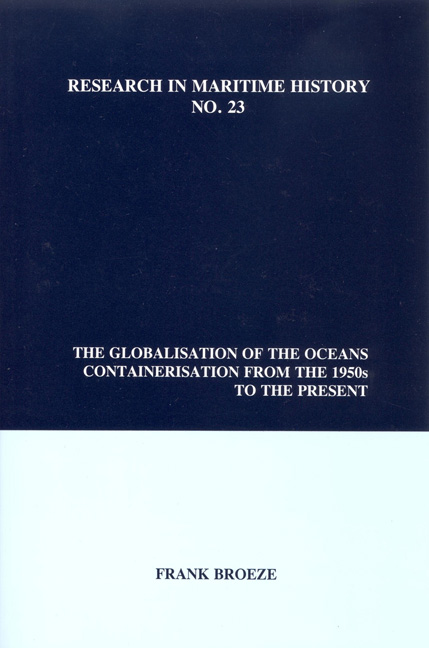Book contents
- Frontmatter
- Table of Contents
- List of Figures
- List of Tables
- Abbreviations
- Acknowledgments
- Preface
- Introduction
- Chapter 1 A Concept and its Realisation
- Chapter 2 The First Revolution
- Chapter 3 The 1970s: Conquering the World
- Chapter 4 The 1980s: Crisis and the Second Revolution
- Chapter 5 The 1990s: Globalisation
- Chapter 6 Ports, Port Systems and Liner Networks
- Chapter 7 Maritime Labour
- Chapter 8 Culture, the Environment and Recycling
- Conclusion
- Select Bibliography
Chapter 5 - The 1990s: Globalisation
- Frontmatter
- Table of Contents
- List of Figures
- List of Tables
- Abbreviations
- Acknowledgments
- Preface
- Introduction
- Chapter 1 A Concept and its Realisation
- Chapter 2 The First Revolution
- Chapter 3 The 1970s: Conquering the World
- Chapter 4 The 1980s: Crisis and the Second Revolution
- Chapter 5 The 1990s: Globalisation
- Chapter 6 Ports, Port Systems and Liner Networks
- Chapter 7 Maritime Labour
- Chapter 8 Culture, the Environment and Recycling
- Conclusion
- Select Bibliography
Summary
Getting that “third ocean” is a goal every liner operator is pursuing right now, representing the great leap towards a global service.
The most important success factor for the future is the need for total customer awareness by container operators.
Despite their huge size, most container shipping giants have little control over their destiny.
Since 1990, the container shipping industry has above all been characterised by globalisation and the relentless drive of operators to lower costs through enlargement of scale in an industry environment of a chronic tonnage surplus and falling freight rates. Almost all leading companies followed Evergreen's example and expanded their operations, either individually or as members of consortia and, from the mid-1990s, global alliances. Their specific objective was to include the three main east-west trade routes in their service networks. The resulting globalisation was partly driven by supply-side factors, such as the enlargement of scale of individual companies, ensuring that sufficient external funds remained available for investment, and adopting changes in transport, computer and telecommunications technology. But shifting market conditions also created strong demand impulses, as the shipping companies increasingly had to deal with the needs of large trans-national manufacturers such as General Motors, Ford and Volkswagen in cars, Sony and Sanyo in electronics, Du Pont, ICI and Union Carbide in chemicals, and Heineken and Guinness in beer. As these corporations shipped high volumes of trade on many routes, they preferred to deal with single operators rather than a large number of separate companies or consortia; only global companies could satisfy this demand.
But globalisation soon became more than the industry's economic context and a marketing strategy for individual companies. Operating global services, expanding company capacity and increasing market share almost became aims in themselves, a demonstration of “going with the times” and vital elements in the creation of new corporate identities. Because of their growing land-based interests and door-to-door commitments, moreover, container shipowners became increasingly aware that they stood at the heart of the transport infrastructure of the entire world economy and constituted an ever more powerful agent for change. In C.C. Tung's words, “container transportation…provid[es] the vital link to world trade.“
- Type
- Chapter
- Information
- The Globalisation of the OceansContainerisation from the 1950s to the Present, pp. 115 - 164Publisher: Liverpool University PressPrint publication year: 2000



